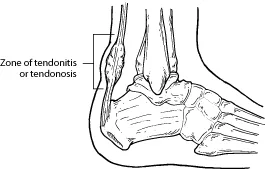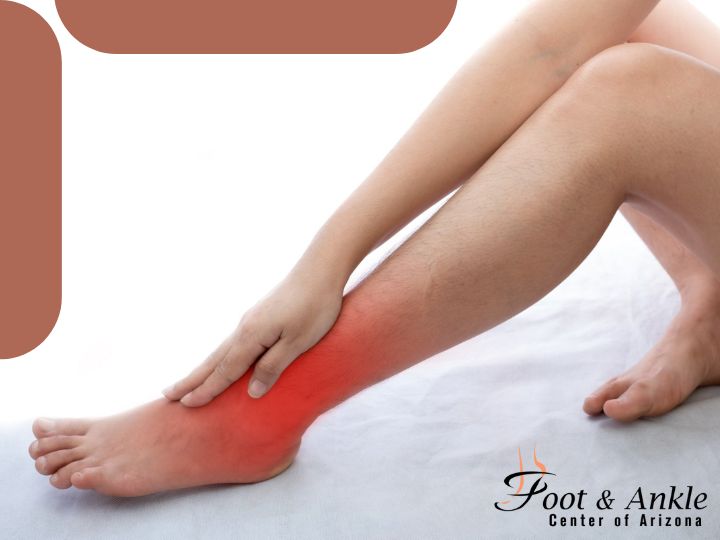What is the Achilles Tendon?
The Achilles tendon, located at the back of the lower leg, serves as the connecting band of tissue linking the calf muscle to the heel bone. Commonly referred to as the heel cord, the Achilles tendo n plays a pivotal role in walking by assisting in the elevation of the heel off the ground.
n plays a pivotal role in walking by assisting in the elevation of the heel off the ground.
Achilles Tendonitis and Achilles Tendonosis
Two prevalent disorders affecting the Achilles tendon are Achilles tendonitis and Achilles tendonosis.
Achilles tendonitis is characterized by inflammation of the Achilles tendon, typically of short duration. If left untreated, it may progress to Achilles tendinosis, wherein the tendon undergoes degeneration, losing its structured integrity and potentially developing microscopic tears. In some rare instances, chronic degeneration, with or without pain, may lead to a tendon rupture.
Causes of Achilles Tendon Disorders
Achilles tendonitis and tendinosis are primarily considered “overuse” disorders, often stemming from a sudden increase in repetitive activities that strain the Achilles tendon. Such activities subject the tendon to excessive stress, resulting in micro-injuries to its fibers. Persistent stress on the tendon impedes the body’s ability to repair the damaged tissue, leading to structural alterations in the tendon and persistent pain.
Athletes are at heightened risk of Achilles tendon disorders. These conditions a re also prevalent among individuals whose occupations place repeated strain on their ankles and feet, such as laborers, as well as among “weekend warriors” who engage in sporadic athletic activities without consistent conditioning.
re also prevalent among individuals whose occupations place repeated strain on their ankles and feet, such as laborers, as well as among “weekend warriors” who engage in sporadic athletic activities without consistent conditioning.
Furthermore, individuals with excessive pronation (flattening of the arch) are predisposed to Achilles tendonitis and tendinosis due to increased demands placed on the tendon during walking. Inadequate footwear can further exacerbate these conditions in individuals with overpronation.
Symptoms of Achilles Tendon Disorders
The symptoms associated with Achilles tendonitis and tendinosis encompass:
- Pain, ranging from aching and stiffness to soreness or tenderness, along the tendon’s course. This discomfort can manifest anywhere from the tendon’s attachment just above the heel to the region below the calf muscle. Pain often intensifies in the morning or after periods of rest, improves somewhat with movement, but worsens with increased activity.
- Tenderness, or occasionally intense pain, when squeezing the sides of the tendon. Direct pressure on the back of the tendon may be less painful.
- In cases of degeneration, the tendon may enlarge and develop nodules in the damaged area.
Diagnosis of Achilles Tendon Disorders
Diagnosing Achilles tendonitis or tendinosis entails a thorough examination of the patient’s foot and ankle, evaluating range of motion and tendon condition. The extent of the condition may be further assessed using X-rays or other imaging techniques.
Treatment of Achilles Tendon Disorders
The choice of treatment for Achilles tendonitis or tendinosis depends on the duration of the injury and the extent of tendon damage. In the early stages marked by acute inflammation, one or more of the following options may be recommended:
- Immobilization: Managing Achilles tendonitis often involves using a cast or a removable walking boot. This helps reduce strain on the Achilles tendon, promoting the healing process.
- Ice: To alleviate swelling caused by inflammation, you can apply a bag of ice wrapped in a thin towel to the affected area for 20 minutes during each waking hour. Remember not to place ice directly against the skin.
- Oral Medications: Nonsteroidal anti-inflammatory drugs (NSAIDs), like ibuprofen, may be recommended to alleviate pain and reduce inflammation, especially during the early stages of the condition.
- Orthotic Devices: Custom orthotic devices may be prescribed for individuals with overpronation or abnormal walking patterns to provide additional support and stability.
- Night Splints: Night splints are designed to maintain a gentle stretch in the Achilles tendon while you sleep, promoting healing.
- Physical Therapy: Physical therapy plays a crucial role in Achilles tendonitis treatment. It typically includes exercises to strengthen the affected area, soft-tissue massage or mobilization, retraining of gait and running techniques, stretching exercises, and the use of ultrasound therapy.
When Is Surgery Necessary?
If nonsurgical approaches fail to restore the tendon to its normal condition, surgery may become necessary. The choice of surgical procedure depends on factors such as the extent of the injury. The patient’s age, activity level, and other considerations.
Prevention
To prevent the recurrence of Achilles tendonitis or tendinosis following surgical or nonsurgical treatment. A foot and ankle surgeon may recommend daily exercises to strengthen and stretch calf muscles. Wearing appropriate footwear tailored to foot type and activity is also crucial in preventing the condition from coming back.
Why Choose a Foot and Ankle Surgeon?
Foot and ankle surgeons are the foremost experts in foot and ankle care. As doctors of podiatric medicine, also known as podiatrists, DPMs, or occasionally “foot and ankle doctors.” They are board-certified surgical specialists in podiatry. Foot and ankle surgeons receive extensive education and training specific to the foot and ankle, surpassing that of any other healthcare provider.
Foot and ankle surgeons address all conditions affecting the foot and ankle. From the simple to the complex, across all age groups, including Achilles tendon disorders. Their rigorous education and training qualify them to perform a wide range of surgeries. Including those indicated for Achilles tendon disorders.




